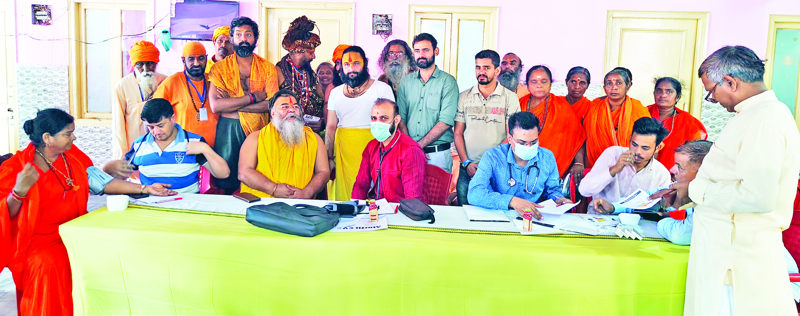Plan a gradual ascent to prevent High Altitude Symptoms: Dr Sushil

STATE TIMES NEWS
JAMMU: Keeping in view the ever increasing rush of the devotees enroute Amarnath Yatra which is known for its difficult and high altitude terrains, Head Department of Cardiology GMCH Jammu Dr Sushil Sharma held a day long cardiac awareness-cum-health check up camp and delivered lecture at Shri Ram Mandir, Purani Mandi Jammu to educate the Yatris and masses about the cardiac risks involved at high altitude and ways to prevent them by recognising symptoms and seeking medical care at earliest to prevent mortality and morbidity.
While delivering the lecture Dr Sushil stated that most people who get altitude sickness get AMS, acute mountain sickness. Higher than 10,000 feet, 75 per cent of people will get mild symptoms.
The interactions between the low barometric pressure and partial pressure of Oxygen, climate, individual genetic, lifestyle and socio-economic factors, as well as adaptation and acclimatization processes at high elevations are extremely complex.
It is challenging to decipher the effects of these myriad factors on the cardiovascular health in high altitude residents, and even more so in those ascending to high altitudes with or without pre existing diseases.
He elaborated that there are three categories of AMS: Mild AMS: Symptoms, such as mild headache and fatigue, don’t interfere with your normal activity. Symptoms improve after a few days as body acclimates. Acute mountain sickness can progress to high-altitude pulmonary edema (HAPE) with associated shortness of breath or high-altitude cerebral edema (HACE) with associated confusion. Chronic mountain sickness may occur after long-term exposure to high altitude. If one travel to a high elevation without letting body adjust to the new altitude, may experience altitude sickness. Symptoms include headache and nausea. If one return to a lower elevation, symptoms will likely go away without needing treatment. In severe cases, altitude sickness can be life-threatening, he added.
Dr Sushil in their concluding remarks told that there are Strategies for a safer trip to high altitudes such as Increasing altitude gradually so the body has time to adjust to lower levels of oxygen, Measures such as climb slowly, stay hydrated, intake of more carbohydrates, cover with proper clothing, stay away from alcohol, smoking and medications like sleeping pills, Adjusting medications to reduce the likelihood of cardiovascular events, as directed by a medical professional, Working with a health care professional to determine if any additional medications may be needed to treat certain symptoms, especially if they occur while in a remote location, Identifying the symptoms that should prompt an emergency evacuation, Planning a gradual ascent and establishing emergency descent plans, Awareness of the closest hospitals. Sudden cardiac death is the most frequent non-traumatic cause of death at altitude, according to the statement. It may occur without warning and result in death within minutes if the individual does not receive treatment. Risk factors for sudden cardiac death include history of a prior heart attack, as well as male sex and older age, he said.
Management Committee of Shri Ram Mandir Mahant Rameshwer Dass, Dr. Satyanarian Dass, Shamsher Singh Manhas (Former MP), Suraj Singh ( DDC Vice Chairman), Anita Sharma (Corporator) and prominent members of the civil society also graced the occasion and appreciated the efforts of Dr. Sushil and his team for creating awareness on this relevant subject. Others who were part of this Camp includes Dr Yashwant Sharma and Dr Kewal Sharma Paramedics and volunteers includes Raghav Rajput, Rajkumar, Rajinder Singh, Jatin Bhasin, Jamshed Ali, Vikas Kumar, Aman Gupta, Rajneesh, Nirvair Singh Bali, Ranjeet Singh, Paramveer Singh and Akshay Singh.
